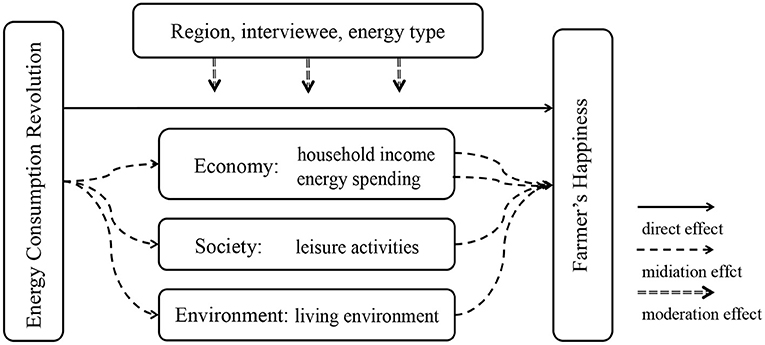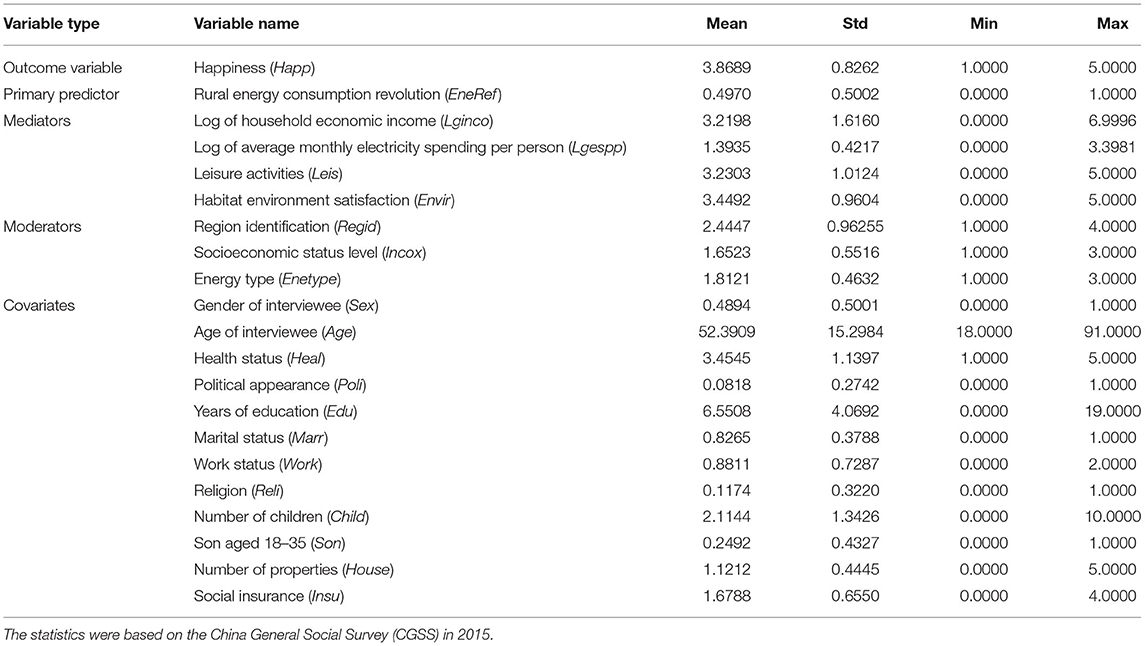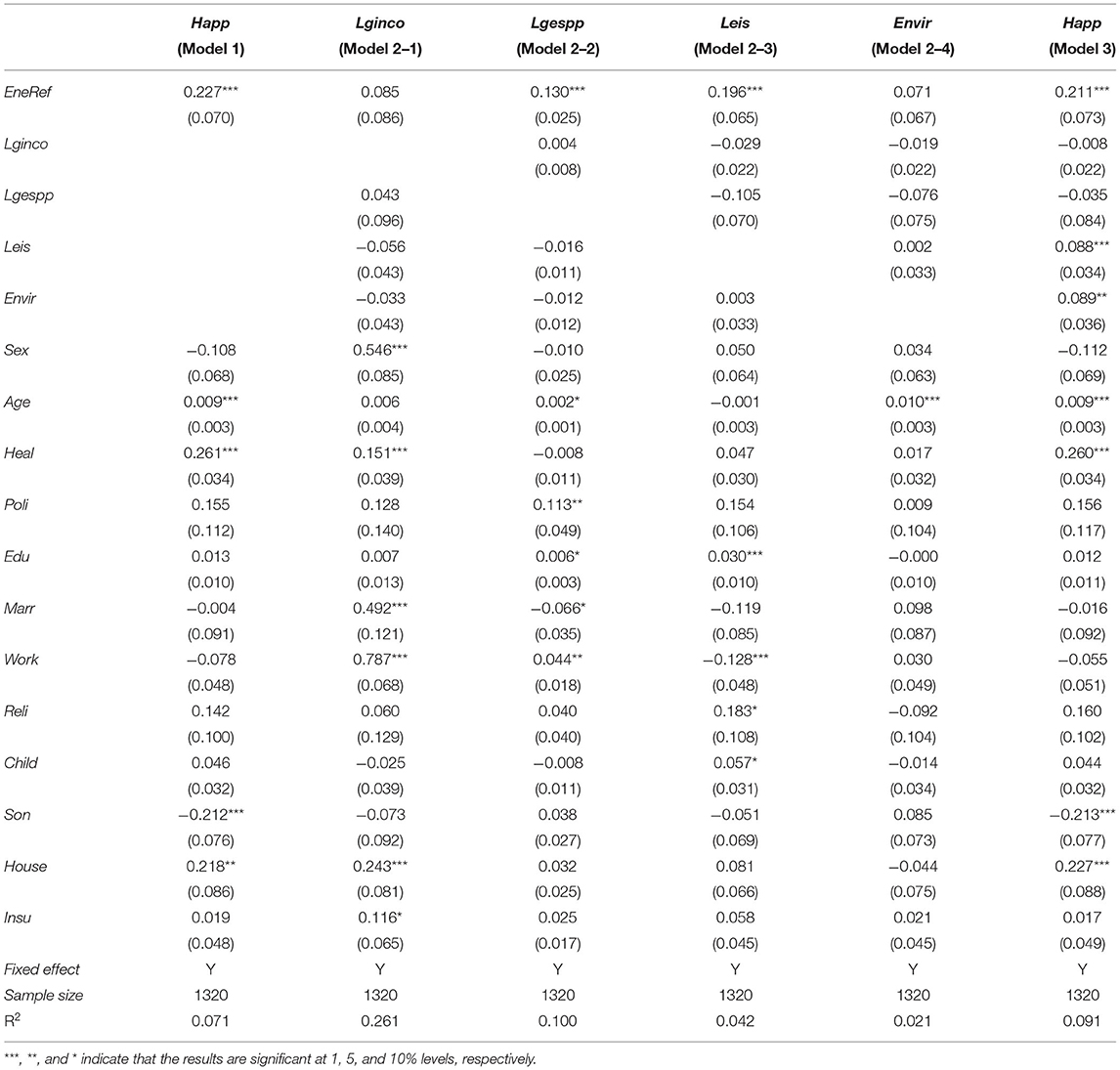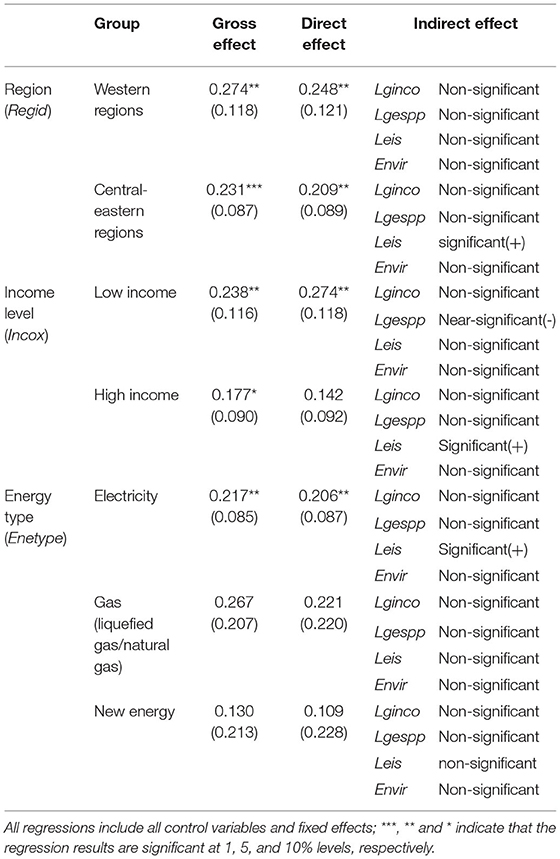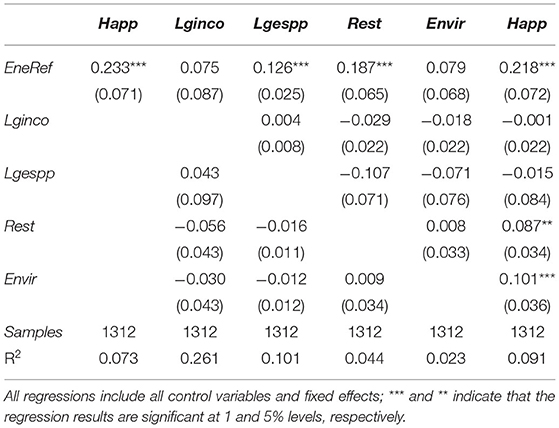- Institute of Natural Resources and Environmental Audits, School of Government Audit, Nanjing Audit University, Nanjing, China
This study divided the impact of energy consumption revolution on farmers' happiness into direct and indirect effects. We empirically tested these effects using the Chinese General Social Survey (CGSS) household data in 2015 and the mediation-moderation model. The results showed that: (1) The rural energy consumption revolution has increased the probability of farmers' happiness level by 22.7%. The direct effects with obvious marginal decrement accounted for the main part (over 90%) of the total effect, but the multi-dimensional mediating mechanism was not yet robust. (2) The revolution of rural energy consumption has slightly improved farmers' happiness through the mediating role of increased leisure activities, while the negative impact of increased use-cost on the happiness of low-income farmers was nearly significant. (3) Regional economy, household income, and energy type played negative roles when moderating the above process. To low-income households in the less-developed western region, the total effects were more evident in the aspect of electricity use. Hence, several policy recommendations have been further made, including inclusive energy and strategic synergies.
Introduction
In response to the Fourth Industrial Revolution, the Chinese government has established the “Energy Consumption Revolution (ECR)” as the essential strategy for China's energy development and formulated concrete plans (1). Specifically, the “ECR” refers to the transition from the traditional energy consumption with intensive emission to the modern energy consumption with low emission (2). However, the Revolution has encountered numerous obstacles in the rural areas of China, the root cause is that Chinese rural population accounts for a high proportion (over 40%) of the total population while sparsely populated throughout China. Whether the Revolution can be successfully implemented in rural China, it depends on not only technological innovations, but also the demand for new energy sources from rural residents. It is crucial to continuously increase rural residents' satisfaction and perception of happiness in the Revolution, so as to motivate their active participation (3).
There is a body of scientific literature on rural energy consumption. First, studies have investigated the Energy Revolution and current status of rural energy consumption. Prior research used energy ladder model, energy stacking model and energy wave model to depict the general course of energy transition (4–6). Some researches described how rural energy consumption evolved from biomass energy (e.g., straw and fuelwood) to the new electrical energy sources [e.g., (4, 7)]. Although the consumption of new energy such as electricity and gas is rapidly growing in China, traditional biomass energy consumption still accounts for more than 60% of total energy consumption in rural China (8, 9). In the rural areas of Beijing, Tianjin and Hebei provinces, fuelwood and coal consumption even accounts for more than 70% of total energy consumption (10). Second, the studies investigated the issue of rural energy supply in China showed, although the commercialization of rural energy is developing fast, due to high costs of energy use, limited technological innovation and financial investment, there are still many challenges in sustainably supplying energy in rural China (11). The urgent problems which need to be solved for rural Energy Reform include the severe pollution from cheap coal energy, the high price and low utilization of clean gas and electricity energy, and the high operating cost of biogas (12). Third, after studying the energy demand in rural China, it is found that household income and the price of energy are the two key factors influencing the demand of rural household energy consumption (13–15). As income level rises, the need for energy upgrade increases for those households (16, 17). It has been proposed that the primary goal of China's energy consumption revolution is to achieve “coal-free” and “fuelwood-free” in the rural areas (2).
Prior research has also explored how energy upgrade impacts the socioeconomic and physical environment, as well as how the socioeconomic and physical environment impacts perceived happiness in rural China. Energy upgrade can significantly reduce the time women spend on housework, on the other hand, increase the time they can spend on leisure activities, increase leisure time and allow rural residents to socialize, entertain, and rest, leading to increased happiness (18). Furthermore, the reduction of traditional energy consumption, such as fuelwood and coal, has greatly decreased the emission of air pollutants such as CO2, SO2, and NOx, which improves the air quality in rural China sharply (15, 19). Improvements for living environment can significantly increase farmers' happiness (20). Thereinto, air quality has been proved playing a significant role when impacting, especially on rural residents' happiness (21). However, there were few studies focus on the relationship between energy consumption and happiness in rural China. Considering the recent energy consumption revolution, this study aimed to quantify the impact of energy consumption on farmers' happiness.
Mechanism Analysis
Based on the analysis framework of mediation and moderation effects in social psychology, we constructed a conceptual model of the mechanism for energy consumption revolution improving farmers' happiness, as shown in Figure 1. The effects of energy consumption revolution on farmers' happiness include direct effect, mediation effect and moderation effect. Thereinto, the mediation effect consists of three dimensions of economy, society and environment, while the moderation effect contains three dimensionalities: region, economic status of respondents and energy type.
First, the direct effect refers to that the energy consumption revolution directly improves farmers' happiness. On the one hand, using new energy brings rural residents a more comfortable and convenient life, directly increasing people's sense of contentment and happiness; On the other hand, the installation and use of new energy devices bring farmers a strong 'demonstration effect' and pride among neighborhood (22). Although the impact of material consumption on people's happiness is non-linear (23, 24), the marginal effect brought by energy consumption revolution is often positive, especially for rural residents in regions with relatively backward economy (25).
Secondly, the mediation effect refers to that the rural energy consumption revolution indirectly improves farmers' happiness from three dimensions: economy, society and environment. Thereinto, (1) economic dimension refers to that energy consumption revolution enables farmers to devote more time to work and obtain higher income, thus increasing their sense of contentment and happiness (26, 27); meanwhile, the energy consumption revolution may also have negative economic effects, such as resulting in higher energy use costs which will partly neutralize people's happiness. In this paper, household income and electricity cost were used to represent the mediators of these two aspects respectively. (2) The social dimension refers to the fact that the energy consumption revolution liberates farmers from complicated housework and enables them to enjoy more rest, leisure and entertainment time, thus gaining more sense of happiness (28). Here leisure time was used to proxy this mediator variable. (3) The environmental dimension means that the energy consumption revolution can improve the rural living environment and make farmers get more happiness (19). Here people's satisfaction with living environment is used as an intermediary.
Third, some key factors play moderating roles in the process of energy consumption revolution to improve farmers' happiness. (1) People's ability to accept new things differs from regional development levels, so there are certain differences in the mechanism of energy consumption revolution influencing happiness (20, 29). (2) People who are at different socioeconomic levels have significant structural differences in the sources of happiness, and they are various in the process of energy consumption revolution to improve happiness (30). (3) For different energy types, people show different acceptability, and the corresponding effects on people's happiness also vary.
Based on the above analysis, we put forward the following three hypotheses to be tested. (H1) Rural energy consumption revolution can directly improve farmers' happiness. (H2) Rural energy consumption revolution can indirectly improve farmers' happiness through economic, social and environmental dimensions. (H3) Region, people's socioeconomic level and energy type play regulatory roles in the process of consumption revolution to improve happiness.
Materials and Methods
Data Source
We analyzed data from the Chinese General Social Survey (CGSS) which started in 2003. Every a few years, the CGSS randomly selects and surveys over 10,000 urban and rural households from all over China. Since 2015, the CGSS questionnaire has added an “Energy Module”, which contains 115 questions related to energy use. In the 2015 CGSS, 10,967 households were interviewed in total. Therein, 3,653 households finished the Energy Module, while 1,472 of them were rural households. In this study, after removing households missing data on essential variables (e.g., happiness, electricity spending), we analyzed data from 1,320 rural households.
Model Variables
The mediation-moderation models were further applied based on the collected CGSS data. All the involved model variables were listed as follows:
Primary Outcome
The primary outcome variable was subjective happiness (Happ). The CGSS included the question “Do you think your life is happy?” with five response options: very unhappy, relatively unhappy, not happy, relatively happy, and very happy. We assigned values 1–5 to the responses, a higher value indicating the greater happiness.
Primary Predictor
The primary predictor was the response to the rural energy consumption revolution (EneRef ). We defined EneRef as the consumption pattern shifting from traditional energy (e.g., fuelwood, straw, and coal) to modern clean energy (e.g., electricity, liquefied gas, natural gas, biogas, and solar energy) (2). If a household has completed the transition to modern energy in at least two of the three activities involving energy consumption (i.e., cooking, showering, and heating/cooling), the household is considered as having responded positively to the national call for energy consumption revolution (EneRefi = 1). In contrast, if a household does not complete the transition as defined, then EneRefi = 0 (9).
Mediators
The mediators included: (i) annual household income in natural logarithm (Lginco), (ii) monthly average electricity spending per person in natural logarithm (Lgespp), (iii) leisure activities (Leis), and (iv) satisfaction with living environment (Envir). Leisure activities were measured using the question “How often do you engage in leisure activities to rest or relax?”, with response options being: never, rarely, sometimes, often, and very often. Satisfaction with living environment was measured using the question “Are you satisfied with the local government's performance on environmental protection?”, with response options being: very dissatisfied, dissatisfied, average, satisfied, and very satisfied.
Moderators
The moderators included: (i) geographic region of the household (Regid): Eastern, Central, or Western China, (ii) perceived socioeconomic status (Incox), and (iii) Energy type (Enetype): fuelwood/coal, electricity, liquefied gas/natural gas, or new energy. Perceived socioeconomic status was measured using the question “How do you think about your socioeconomic status by comparing with your peers?”, with response options being: lower, almost the same, and higher (20).
Covariates
Covariates included participant, household, and regional features. First, we considered nine participant features, consisting gender (Sex), age (Age), health status (Heal), political affiliation (Poli), years of education (Edu), marital status (Marr), employment status (Work), religion (Reli) and insurance (Insu). Therein, health status were categorized into very unhealthy, relatively unhealthy, average, relatively healthy, or very healthy; political affiliation were categorized into yes for members of the communist party or communist youth league, or no for non-members; marital status were categorized into married or unmarried/divorced/widowed; employment status were categorized into jobless, farmer, or non-farmer; religion were categorized into having any religion or having no religion; and insurance were measured as having each of the four insurance types: basic medical insurance, basic pension, commercial medical insurance, and commercial pension. Second, we considered three household features: quantity of children (Child), whether there was a son aged 18–35 (Son) (29), and number of houses (House). Third, we considered a regional characteristic (Regn), which represented the provinces in China.
The descriptive statistics for all the above variables can be found in Table 1.
Model Analysis
We conducted data analysis in three steps using STATA version 16. First, using subjective happiness as the outcome, we built benchmark regression models, take response to the rural energy consumption revolution and the covariates as the predictors (20, 29–31).
In Equation (1), Happi is the ith household's subjective happiness, EneRefi is the binary variable indicating whether the farmer responded positively to the energy consumption revolution, Contmi is a series of covariates including participant and household characteristics, Regnj is the fixed effect for the jth province, Ctem is a constant, and εi is the random error.
Second, to inspect potential mediation effects, we built mediation models by adding mediators into the above benchmark model as follows:
In Equations (2) and (3), Medi is the potential mediators (i.e., Lginco, Lgespp, Leis or Envir). Since Happ, Leis and Envir are ordinal variables, we modeled these variables with ordered probability model. The other outcomes were modeled with linear regression based on the Ordinary Least Squares (OLS) method.
When using the ordered probability model in mediation analysis, the decomposition of total effect based on the traditional linear regression is not applicable. Therefore, we adopted the modified mediation effect test and decomposition method as described in (32, 33). In this method, the first step is to conduct a coefficient t-test of rural energy consumption revolution (EneRef ) in the benchmark model (Equation 1). If αxy is significant, we proceed to the second step; otherwise, the mediation effect is considered to be non-significant. The second step is to test models in Equation (2) and (3) separately. If the t-tests for both αxz and αzy are significant, we would skip third step and move forward to the fourth step; otherwise, we would proceed the third step to conduct an Iacobucci-z test:
In Equation (4), zxz and zzy are the t-statistics of αxz and αzy in regression models 2 and 3. If the test results for Iacobucci-z is not significant, the mediation effect will be non-significant. If the Iacobucci-z test is significant, we proceed to the fourth step, in which we will determine whether the t-test of is significant or not. If the t-test is non-significant, it will be a complete mediation effect. In contrast, if there is significant t-test, then it indicates a partial mediation effect and the Breen decomposition must be used to calculate the direct and indirect effects in the fifth step (33). In step 5, we define σe=sqrt(3)σε/π, where σε is the standard error of the random error εi in Equation (3), the direct effect is /σe, the mediation effect is αxzαzy/σe, and the total effect is (Σαxzαzy)/σe.
Lastly, we built separate mediation models stratified by the moderators (i.e., Regid, Incox, and Enetype).
Results
Respondents' Characteristics
In the 1320 rural households included in this analysis, there were respectively, 14 (1.1%), 91 (6.9%), 191 (14.5%), 782 (59.2%), and 242 (18.3%) households chose “very unhappy”, “relatively unhappy”, “Just so-so”, “relatively happy” and “very happy” (Figure 2A). In cooking activity, 35% of the total households remained to use fuelwood and coal, while 45% and 20% chose electricity and gas, separately; for showering, 45% still used fuelwood and coal, while 18% and 12% used solar and electricity, separately; for heating/cooling, 63% still kept fuelwood and coal, while 37% used electricity (Figure 2B). Overall, a total of 656 (49.7%) households responded positively to the call for rural energy consumption revolution through various measures. However, only 23.5% of the 1,320 households completed the structural transition to modern energy in all of the three main energy consumption activities.
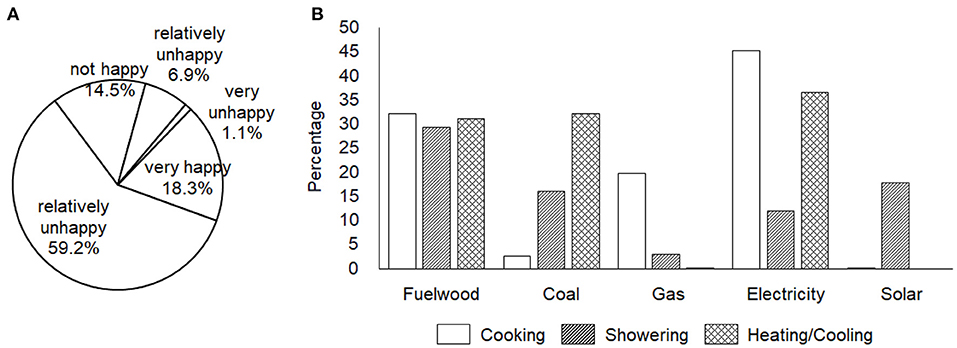
Figure 2. The data distribution of happiness index (A) and energy consumption revolution (B) based on the China General Social Survey (CGSS) in 2015.
Benchmark Regression Models
We summarized the results from benchmark regression models in Table 2. Regression model 1 shows that, responding proactively to the energy consumption revolution may increase the probability of enhancing farmers' happiness level by 22.7%. The regression results for (2–1), (2–2), (2–3) and (2–4) of potential mediating variables Lginco, Lgespp, Rest and Envir, showed that the rural energy consumption revolution did not significantly increase household income, while it significantly increased per capita electricity expenditure and also the rest time of farmers. Likewise, it was inapparent in the impact on the satisfaction of rural living environment. Furthermore, regression models 1 and 3 show that older age, better health status, and possessing more house property were significantly associated with increasing of happiness, while having a son aged 18–35 was significantly associated with decreasing of happiness. It is not observed any significant association among happiness and other covariates including sex, political affiliation, years of education, marital status, employment status, religion, number of children in the household, and insurance.
Mediation Analysis
We summarized results from the mediation models in Table 3. As showed in the table, the tests of αxy, αxz, αzy and were t-test statics about coefficient of rural energy consumption revolution (EneRef ) in the benchmark models 1, 2, and 3. The Iacobucci-z test was used to confirm the significance when only one of the αxz and αzy was significant. In the first step, αxy test was significantly positive for all mediators. In the second step, the αxz test was significantly positive for electricity expenditure (Lgespp) and leisure activities (Leis), but non-significant for household income (Lginco) and living environment satisfaction (Envir). In the third step, the αzy test is significantly positive for leisure activities (Leis) and living environment satisfaction (Envir), but non-significant for household income (Lginco) and electricity spending (Lgespp). In the fourth step, the Iacobucci-z test showed that the mediation effects of electricity spending (Lgespp) and living environment satisfaction (Envir) were not significant. In the fifth step, the test revealed that only leisure activities (Leis) were a significant mediator of the relationship between energy consumption revolution and farmers' happiness. The other potential mediators were not significant.

Table 3. Testing results and decomposition of the mediation effect of energy consumption revolution on improving farmers' happiness.
We further applied the Breen decomposition to quantify the mediation effects. As seen in Table 3, in the relationship where rural energy consumption revolution significantly increased farmers' happiness the direct effect accounted for over 90% of the total effect and the mediation effect accounted for <10% of the total effect. All of the mediation effects were brought by increased leisure activities (Leis), while the mediation effect of economic [i.e., household income (Lginco) and electricity spending (Lgespp)] and environmental (Envir) factors was not significant.
Moderation Analysis
We summarized results from the moderation analysis in Table 4. As seen in the table, the effect of energy consumption revolution on farmers' happiness varied slightly across geographic regions. Overall, the direct effect of energy consumption revolution on increasing farmers' happiness decreased from the western to central-eastern regions, with the largest value being observed in the less-developed western region. Besides, farmers in the more-developed central-eastern region are more likely to prefer leisure activities when they have time. So, the leisure activities were significantly increased because of the energy consumption revolution in central-eastern China, which in turn significantly increased farmers' happiness.
Table 4 reported the moderation effect of household income (Incox) on the relationship between energy consumption revolution and farmers' happiness. We observed large differences in the effect of the energy consumption revolution on happiness across different household income levels. First, the direct effect of energy consumption revolution on happiness decreased from the low-income households to middle and high-income households. Second, farmers from middle- and high-income households cared more about leisure activities. The energy consumption revolution significantly increased the happiness of middle- and high-income farmers by increasing leisure activities, but the mediation effects of economic and environmental factors were not significant. Third, low-income farmers were more susceptible to the rising cost of clean energy. The energy consumption revolution near significantly reduced the happiness of low-income farmers because of the increasing electricity spending by energy consumption revolution.
The moderation effect of energy type (Enetype) was also reported in Table 4. Different types of energy had differential effects on farmers' happiness. First, the total effect of electricity, gas, and new energy on increasing farmers' happiness decreased in this order, with only electricity being significant. Second, electrical energy consumption significantly increased farmers' happiness by increasing leisure activities, while the effect of new energy sources such as liquefied gas, natural gas and especially solar energy was not significant.
Endogenous Treatment and Robustness Test
Endogenesis may come from a variety of complex factors, which can lead to systematic bias in estimates. As the model was based on cross-sectional data, propensity score matching (PSM) method was adopted to deal with the endogeneity problem (34). According to all control variables, 656 households were matched with 1:1 nearest neighbor, and 1312 matched regression samples were obtained. We found that there was a significant difference in density distribution between the control group and the treatment group before matching, and the density distribution of the control group was closer to that of the treatment group from all dimensions after matching, so the “systematic bias” between the control group and the treatment group could be better eliminated, and the propensity score matching achieved a good effect.
Further, we did a re-regression of the above benchmark and mediation model based on matched samples (Table 5). In terms of the magnitude, direction and significance of the key coefficients,the regression results before and after matching were consistent. Therefore, it is believed that there is no obvious bias in our models and the endogeneity problem will not have a systematic impact on the regression model.
Also, we did a serial of robustness tests. First, we adjusted the definition of Energy consumption Revolution from “If a household i has completed at least two of the three activities involving energy consumption, then EneRefi = 1” to “If a household i has completed all the three activities involving energy consumption, then EneRefi = 1”. Second, we changed the regression method from Ordered Probit to Ordered Logit. Third, we did a Placebo test by manufacturing a treatment variable of Energy consumption Revolution with the random selection. We randomly selected 656 farmers from 1320 samples as the counterfactual treatment group of rural energy consumption revolution, constructed a pseudo-explanatory variable (EneRef_fake), and used it to estimate the above benchmark model. The above process was repeated 500 times and 1000 times respectively, and the density distribution of the regression coefficient (αxy) of the primary explanatory variable (EneRef_fake) was obtained, as shown in Figure 3. This key variable, i.e., the EneRef_fake's regression coefficient αxy, was concentrated around 0, and the 1000 random results (right) were closer to 0 than the 500 random results (left). These results indicated that all these robustness tests were passed.

Figure 3. Placebo test results using 500 and 1,000 random counterfactual explanatory variables. All regressions include all control variables and provincial fixed effects.
Discussion
Overall, our results show that the rural energy consumption revolution improved farmers' happiness. However, the mediation analyses show that the direct effect accounted for over 90% of the total effect; the revolution increased farmers' happiness is only through increasing leisure activities, but not through improving household income or living environment. To achieve ultimate success for energy consumption revolution to be successful, it must realize the full potential of the revolution by promoting its impact on the socioeconomic and environmental factors, so as to develop a multi-dimensional mechanism for increasing happiness.
While the rural energy consumption revolution has marginally increased farmers' happiness by increasing leisure activities, its negative impact on happiness for higher electricity expenditure is also significant especially to rural low-income households. In other words, the revolution is a double-edged sword, not only to increase leisure activities by liberating people from daily chores, but also to raise people's electricity expenditure, which leads to additional financial burden for rural low-income households. Therefore, when promoting the energy consumption revolution in rural areas, it is important to regulate electricity and gas prices, so as to guarantee that they are affordable for farmers. In addition, the energy consumption revolution has yet to improve the rural living environment, which reflects a low energy utilization rate (i.e., incomplete energy upgrades) in rural China.
Our results also show that geographic region and household income level moderated the relationship between energy consumption revolution and farmers' happiness. It is found that rural residents of less-developed Western China or low-income households were more likely to respond to the energy consumption revolution. Besides, rural residents of Central-Eastern China, where are more-developed, including middle and high-income households, pay more attention to increasing leisure activities brought by the energy consumption revolution, while rural residents of Western China or low-income households were more sensitive to the spending of electricity use.
Results from our study are meaningful for policy implications. First, it is difficult to promote the rural energy consumption revolution only as a national policy. It is important to act synergistically, by implementing or integrating it with other relevant national policies, such as policy for ‘Pollution Prevention and Abatement' (35) and ‘Poverty Reduction' (36). It is observed that only 23.5% of the rural households have completed energy upgrade, it shows that the revolution did encounter obstacles in rural China. Lack of a multi-dimensional mechanism for improving farmers' happiness is the main reason for it. Therefore, it is necessary to synergistically implement the rural energy consumption revolution with the national targeted poverty alleviation policy as well as the national pollution prevention and control policy, forming a multi-pronged strategy that simultaneously targets the socioeconomic and environmental factors associated with farmers' happiness.
Second, from the perspectives of both equity and efficiency, to introduce an energy policy that favors the poor Western regions and low-income households are important for promoting the rural energy consumption revolution. In terms of equity, “Energy Poverty Reduction” (37) is an important part of the national target of poverty reduction policy. Our results suggest that promoting the energy consumption revolution in Western China and low-income households can increase happiness. As to efficiency, the poor Western China and low-income households should be paid more attention in the energy consumption revolution. The benefits of the new energy policy, including national investments in energy infrastructure, subsidies for terminal equipment (e.g., heater, refrigerator, and air conditioner), especially price regulations related energy use, should be introduced firstly to the poor rural areas, so that farmers' happiness can be increased. In return, it will further facilitate the rural energy consumption revolution.
Data Availability Statement
Publicly available CGSS datasets were analyzed for this study, which can be found here http://cgss.ruc.edu.cn/. Further inquiries can be directed to the corresponding author.
Author Contributions
ZX conceived the model and analyzed results. RG collected the data. ZX and RG wrote the manuscript together. All authors contributed to the article and approved the submitted version.
Funding
This study was supported by the China National Philosophy and Social Science Foundation in 2021: Research on the dynamic mechanism and realization path of urbanization with county as an important carrier (21BJY017).
Conflict of Interest
The authors declare that the research was conducted in the absence of any commercial or financial relationships that could be construed as a potential conflict of interest.
Publisher's Note
All claims expressed in this article are solely those of the authors and do not necessarily represent those of their affiliated organizations, or those of the publisher, the editors and the reviewers. Any product that may be evaluated in this article, or claim that may be made by its manufacturer, is not guaranteed or endorsed by the publisher.
Acknowledgments
We wish to thank the CGSS staff for their dedication to survey data collection and processing.
References
1. Schwab K. The fourth industrial revolution: what it means, how to respond. Economy, Culture & History Japan Spotlight Bimonthly. (2016) 3–5.
2. Ni W, Jin Y, Ma L, Hu S. A Preliminary Discussion on Strategic Issues of Promoting the Revolution of Energy Consumption and Controlling the Total Energy Consumption in China. Strategic Study of CAE. (2015) 17:111–7.
3. Xi J. Secure a decisive victory in building a moderately prosperous society in all respects and Strive for the great victory of socialism with Chinese characteristics in the new era. The Report of the 19th National Congress of the CPC. People's Publishing House, Beijing (2017).
4. Leach G. The energy transition. Energy Policy. (1992) 8:116–23. doi: 10.1016/0301-4215(92)90105-B
5. Masera OR, Saatkamp BD, Kammen DM. From linear fuel switching to multiple cooking strategies: a critique and alternative to the energy ladder model. World Dev. (2000) 28:2083−103. doi: 10.1016/S0305-750X(00)00076-0
6. Zhang R, Wei TY, Sun J, Shi QY. Wave transition in household energy use. Technol Forecast Soc Change. (2016) 102:297–308. doi: 10.1016/j.techfore.2015.08.014
7. Barnes DF, Floor W. Biomass energy and the poor in the developing countries. Int Aff. (1999) 53:237–59.
8. Qiu H, Yan J, Li D, Han W. Residential energy consumption in rural China: current situation and determinants for future trend–an empirical study based on filed survey data of 4 provinces. China Soft Sci. (2015) 11:28–38. doi: 10.3969/j.issn.1002-9753.2015.11.004
9. Household Energy Consumption Research Group. Chinese Household Energy Consumption Research Report (2015). The annual report of national academy of development and strategy, Renmin University of China (2016).
10. Xu Y, Huang L. Beijing-Tianjin-Hebei rural energy consumption structure research. J Hebei Univ Econ Bus. (2018) 39:65–73. doi: 10.14178/j.cnki.issn1007-2101.2018.03.009
11. Xiong W, Fu Z, Wang P. Promotion of rural energy supply side reform under ecological environment construction. Rural Econ. (2017) 12:94–9.
12. Zhang J. Institutional analysis on sustainable supply of rural energy for livelihood. Prod Res. (2011) 2:25–7.
13. Jain G. Energy security issues at household level in India. Energy Policy. (2010) 38:2835–45. doi: 10.1016/j.enpol.2010.01.016
14. Zhang H, Mou J, Yin H. An empirical analysis of household energy consumption demand in rural areas of forest region-based on a double-extended linear expenditure system model. Chin Rural Econ. (2010) 7:64–74. doi: 10.3724/SP.J.1011.2010.01351
15. Shi Q, Peng X, Zhang R. A field survey on rural energy consumption in China - a case study of 2253 farming households in Jin-Qian-Zhejiang provinces. Manage World. (2014) 5:80–92.
16. Broadhead J, Bahdon J, Whiteman A. Woodfuel Consumption Modelling and Results, Annex 2 in: Past Trends and Future Prospects for the Utilization of Wood for Energy. Working Paper No. GFPOS/WP/05, Global Forest Products Outlook Study, FAO, Rome (2001)
17. Chen L, Heerink N, Berg M. Energy consumption in rural China: a household model for three villages in Jiangxi Province. Ecol Econ. (2006) 58:407–20. doi: 10.1016/j.ecolecon.2005.07.018
18. Zheng F, Liu J. The impact of household energy consumption structure on rural women's time allocation: a case study of Zhijin County, Guizhou Province. J Agrotech Econ. (2010) 10:72–81.
19. Zhang R, Wei TY, Glomsrød S, Shi QH. Bioenergy consumption in rural China: evidence from a survey in three provinces. Energy Policy. (2014) 75:136–45. doi: 10.1016/j.enpol.2014.08.036
20. Chen G, Li S. How can government make people happy? An empirical study of the impact of government quality on residents' happiness. Manage World. (2012) 8:55–67.
21. Yang J, Zhang Y. Pricing air pollution: an analysis based on happiness data. J World Econ. (2014) 37:162–88.
22. Zimmermann S. The Pursuit of subjective well-being through specific consumption choice. Available at SSRN 2484660.
23. Easterlin RA. Does economic growth improve the human lot? Some empirical evidence. Nat Households Econ Growth. (1974) 89:89–125. doi: 10.1016/B978-0-12-205050-3.50008-7
24. Easterlin RA, Morgan R, Switek M, Wang F. China's life satisfaction, 1990–2010. Proc Natl Acad Sci USA. (2012) 109:9775–80. doi: 10.1073/pnas.1205672109
25. Sun J, Wei W. A study on the relationship between economic welfare and happiness. Consu Econ. (2016) 32:80–8.
26. Ball R, Chernova K. Absolute income, relative income and happiness. Social Indicator Research. (2008) 88:497–529. doi: 10.1007/s11205-007-9217-0
27. An H, Ye J. The effect of housing price on happiness and its mechanism. Guizhou Soc Sci. (2018) 4:109–16.
28. Luorong Z. Leisure and happiness-a study of the changes of labor inputs of Tibetan farmers. J Minzu Univ China. (2016) 6:82–8.
30. Ma W, Wang X, Li H. The impact mechanism of income gap on happiness. Econ Perspect. (2018) 11:74–87.
31. Wen Z, Hou KT, Zhang L. A comparison of moderator and mediator and their applications. Acta Psychol Sinica. (2005) 37:268–74.
32. Buis ML. Direct and indirect effects in a logit model. Stata J. (2010) 10:11–29. doi: 10.1177/1536867X1001000104
33. Breen R, Karlson KB, Holm A. Total, direct, and indirect effects in logit and probit molels. Sociol Methods Res. (2013) 42:164–91. doi: 10.1177/0049124113494572
34. Leng C, Zhu Z. Research on the happiness effect of internet on rural residents. S Chin J Econ. (2018) 8:107–27. doi: 10.19592/j.cnki.scje.351019
35. World Bank Group. Pollution Prevention and Abatement Handbook 1998: Toward Cleaner Production. Washington, DC: The World Bank (1999).
36. Freeman HA, Ellis F, Allison E. Livelihoods and rural poverty reduction in Uganda. World Dev. (2003) 31:997–1013. doi: 10.1016/S0305-750X(03)00043-3
37. Cook CC, Duncan T, Jitsuchon S, Sharma A, Guobao W. Assessing the Impact of Transport Energy Infrastructure on Poverty Reduction. Manila: Asian Development Bank (2005). Available online at: https://www.adb.org/sites/default/files/publication/27956/assessing-transport-energy.pdf
Keywords: happiness, energy consumption, farmer, China, mediation-moderation analysis
Citation: Xu Z and Ge R (2022) The Impact of Energy Consumption Revolution on Farmers' Happiness: An Empirical Analysis From China. Front. Public Health 10:778002. doi: 10.3389/fpubh.2022.778002
Received: 16 September 2021; Accepted: 11 January 2022;
Published: 10 March 2022.
Edited by:
Fei Wang, Cornell University, United StatesReviewed by:
Shi Qinghua, Shanghai Jiaotong University, ChinaRongbing Huang, Zhejiang Gongshang University, China
Li Xu, Jiang Xi Normal University, China
Copyright © 2022 Xu and Ge. This is an open-access article distributed under the terms of the Creative Commons Attribution License (CC BY). The use, distribution or reproduction in other forums is permitted, provided the original author(s) and the copyright owner(s) are credited and that the original publication in this journal is cited, in accordance with accepted academic practice. No use, distribution or reproduction is permitted which does not comply with these terms.
*Correspondence: Rong Ge, Z2U3MjE4QDE2My5jb20=
 Zhiyao Xu
Zhiyao Xu Rong Ge*
Rong Ge*